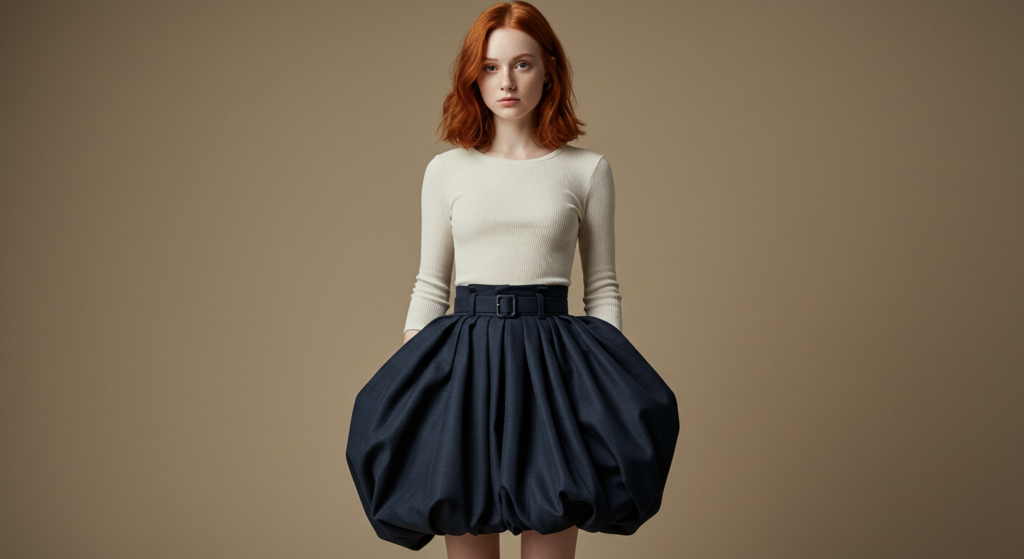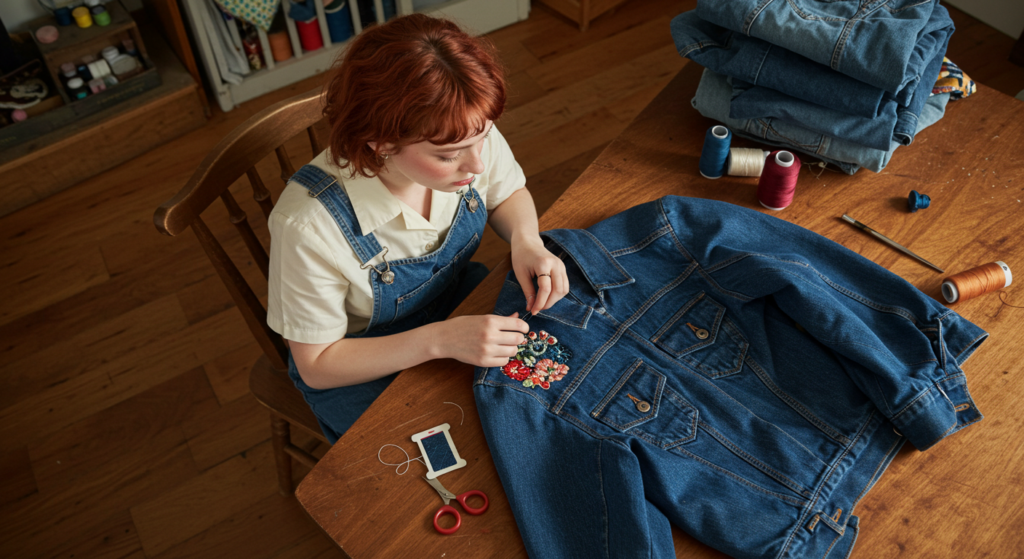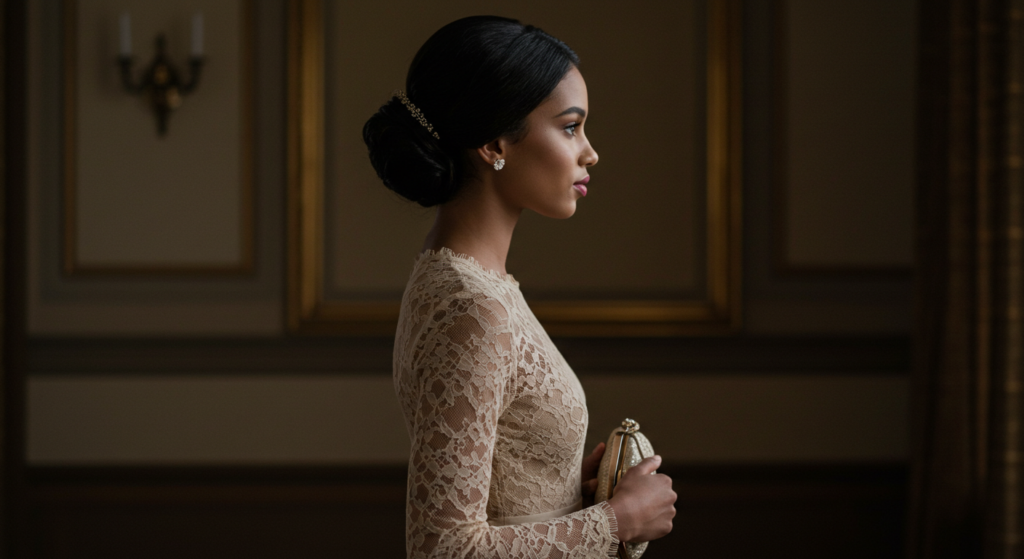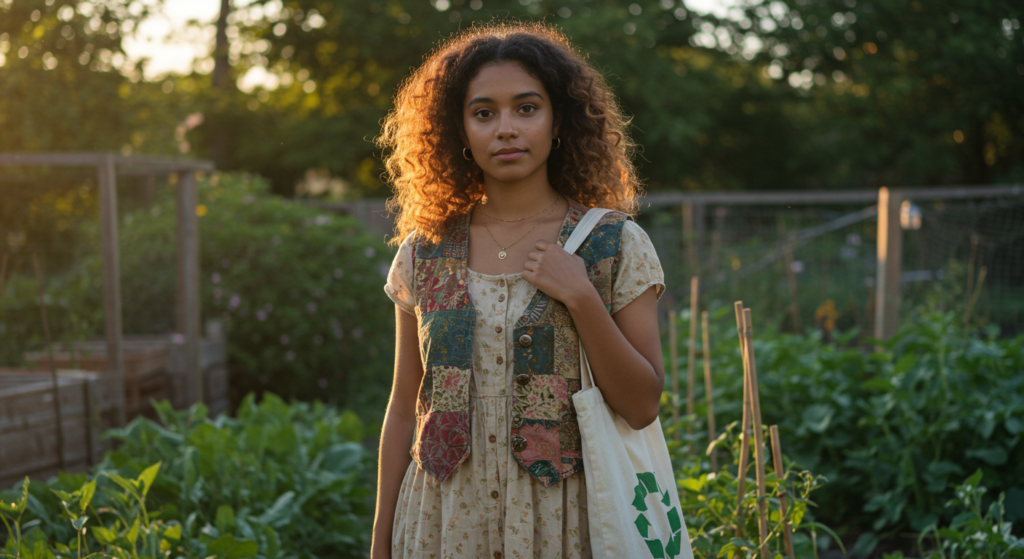Key Takeaways
- Blend Contrasts: Mixing old-fashioned silhouettes with today’s clean lines creates visually striking outfits that stand out.
- Color Coordination: Focus on cohesive color palettes to tie together pieces from different eras without relying on color psychology clichés.
- Fit Matters Most: Tailoring and altering vintage finds can make them look contemporary and polished.
- Details Enhance Style: Accessories and finishing touches bridge the gap between retro charm and modern sleekness.
- Sustainability & Individuality: A vintage-modern fusion promotes eco-friendly choices while letting you develop a personal, one-of-a-kind look.

Finding that sweet spot between modern and vintage is like discovering a hidden treasure chest for your personal style. You get the best of both worlds: contemporary ease and timeless charm. You might have a few old jackets from your grandparents’ attic or a statement piece discovered at your local thrift store, but you’re not sure how to blend them into your daily outfits.
The good news is that you don’t have to be a professional stylist to pull it off. With a bit of creativity and a spirit of exploration, you can merge different eras to create a wardrobe that truly stands out.
In this comprehensive guide, we’ll walk through everything you need to know about meshing modern garments with vintage finds. From color-coordination tactics to fabric care, we’ll dig into practical approaches that can help you build outfits you love. Whether you’re brand-new to this blend or you’ve already got a closet full of retro treasures, you’ll find something here to spark fresh inspiration.
Crafting a Personal Aesthetic with Modern-Vintage Blends

Defining Your Style Goals
Before you dive into mixing modern and vintage, identify what you want your wardrobe to say about you. Are you aiming for a subtle retro accent, or do you want to rock a head-turning statement every time you step out? Having a clear goal keeps you from overbuying and helps you focus on pieces that truly resonate with your vision.
- Create a Mood Board: Gather images of outfits, colors, or even interior design photos that capture the feel you’re after.
- Choose Anchor Pieces: Decide on a few standout items—like a 1960s-inspired coat or a pair of futuristic sneakers—that guide the tone of your wardrobe.
- Consider Lifestyle Needs: If you spend most of your week in an office environment, your style goals should include pieces that bridge professional expectations with your love for vintage flair.
Identifying Your Favorite Eras
Vintage isn’t just a single style; it’s a vast collection of trends and silhouettes from various decades. You might be drawn to the clean lines of the 1950s, or perhaps the bold prints of the 1970s. By pinpointing which era(s) you love most, you’ll have a clearer roadmap for what to look for when thrift shopping or browsing online stores.
- Experiment in Small Doses: Try out a piece or two from different decades to see what clicks.
- Mix Eras with Caution: While blending multiple retro styles can be exciting, be sure to avoid visual overload by picking a key decade to highlight and using others as accents.
- Note the Silhouettes: Each era offers unique fits—like nipped waists in the ‘50s or flared legs in the ‘70s—so seek silhouettes that flatter your body type and align with your style goals.
Merging Past and Present for Authenticity
Authenticity is key. Simply throwing on a random old hat with a modern dress might look forced unless you integrate thoughtful design and color elements. Embrace the stories and craftsmanship behind vintage pieces, then give them a contemporary context by pairing them with updated fabrics and current shapes.
- Highlight Unique Details: Vintage clothes often have special embroidery, lace detailing, or button designs. Pair these with more minimal modern items to let those details shine.
- Understate or Overstate Intentionally: Balance is everything. If the vintage piece is bold, keep the modern companion items subtle, and vice versa.
- Keep It Personal: Ultimately, there’s no right or wrong. If it makes you feel confident, that sense of authenticity will radiate from your outfit.
Choosing Color Palettes that Bridge Eras

Main Hues to Unite Modern and Vintage
When pulling looks from different time periods, color can be the unifying element. A consistent color palette makes an outfit look cohesive rather than chaotic.
- Base Tones: Choose neutral shades like black, white, beige, navy, or gray as your core. These help anchor vintage patterns or shapes.
- Soft Coordination: If you have a vintage burgundy blazer, try pairing it with a modern top in a soft, related shade—like mauve or dusty rose—to create a subtle tie.
- Limit the Palette: Aim for two or three main colors in one outfit. This approach ensures you’re merging eras instead of mixing them chaotically.
Accent Shades for Unique Pops
Sometimes, you want a bright accent to keep the look from feeling monotonous. Accent shades are especially helpful when vintage patterns feature distinct hues.
- Pop of Color: Adding a bold modern accessory—like neon sneakers—to a neutral vintage dress can be a fun twist.
- Draw from Prints: If your vintage skirt has small teal flowers, use that teal as an accent color in your belt or modern jacket.
- Placement Matters: Focus your accent color on a single region of the outfit, such as the waist or neckline, for maximum impact.
Neutral Bases for Effortless Pairing
Neutrals are the unsung heroes of a balanced wardrobe. They make it easier to blend prints, silhouettes, and textures from various eras.
- Classic Canvas: A simple, modern T-shirt in white or black can showcase a vintage patterned skirt beautifully.
- Reliable Outerwear: A neutral trench coat or denim jacket seamlessly ties together a range of color combinations.
- Layering Opportunity: Neutrals let you stack vintage and contemporary layers without clashing.
Finding Vintage Gems

Hunting at Thrift Stores and Flea Markets
Local thrift stores, charity shops, and flea markets can be goldmines for unique, affordable pieces. Keep an open mind, and remember to check every section, including men’s or plus-size aisles, for hidden treasures.
- Visit on Restock Days: Ask staff when they usually restock so you can get first dibs on fresh items.
- Carry a List: Having a rough list of what you need—like a vintage blazer or a 1960s print dress—helps you stay focused amid the racks.
- Assess Condition: Inspect seams, zippers, and any visible stains. Minor flaws are fixable, but extensive damage might not be worth the effort.
Exploring Online Vintage Platforms
If local options are limited, online vintage retailers and auction sites open up a global marketplace. You can filter by era, price, or brand, making it easier to pinpoint special finds.
- Check Seller Ratings: Reviews can clue you in on whether items are accurately described.
- Compare Prices: Some online stores mark up vintage heavily. Cross-check items on auction sites or peer-to-peer marketplaces for better deals.
- Ask for Measurements: Vintage sizing can differ greatly from modern sizing. Request waist, bust, and shoulder measurements to ensure a good fit.
Quality Checks: Zippers, Buttons, and Labels
Vintage items can range from pristine to well-worn, so do a thorough inspection.
- Zipper Functionality: Test the zipper multiple times. Metal zippers may need oiling, but a broken zipper can be replaced if the piece is otherwise in excellent shape.
- Buttons & Fastenings: Missing or loose buttons can be replaced, but pay attention to whether unique or ornate buttons are missing, as they might be harder to source.
- Authentic Labels: Original labels can help confirm the decade and quality. If the label is partially worn, do some online research to match logos or brand history.
Spotting Modern Must-Haves

Staple Pieces That Anchor Your Wardrobe
Modern wardrobe staples serve as the backbone of your style, letting vintage items shine without dominating your entire look.
- Fitted Blazer or Jacket: Pairs well with a retro graphic tee or a vintage blouse.
- Classic Denim: Skinny, straight-leg, or wide-leg—choose a style that complements the vintage tops or jackets you have.
- Solid-Colored Tops: Simple crewnecks, turtlenecks, or V-necks in neutral shades help anchor bolder vintage pieces.
Trendy Items That Blend Seamlessly
Sometimes, incorporating a current trend can keep your overall look feeling fresh. The trick is to choose trends that play well with your vintage picks.
- Modern Sneakers: Chunky or minimalist sneakers contrast nicely with retro dresses or high-waisted trousers.
- Contemporary Accessories: Think statement belts or geometric bags that echo the shapes of a vintage silhouette.
- On-Trend Outerwear: From oversized shackets to structured leather jackets, a trendy outer layer can make a vintage underlayer feel current.
Investing in High-Quality Basics
When mixing decades, the quality of your base modern items can either elevate or degrade the entire ensemble. A well-made T-shirt or a sturdy pair of pants ensures that your vintage piece looks intentional, not sloppy.
- Fabric Choice: Look for cotton, wool blends, or high-grade synthetic fabrics with a good reputation for durability.
- Construction Details: Reinforced seams and quality stitching help garments last longer and appear more polished.
- Versatility: The best modern basics can be dressed up or down, pairing just as well with your 1970s corduroy pants as with modern chinos.
Layering Techniques

Light Layers for Subtle Contrasts
Layering is a cornerstone of any stylish wardrobe, especially when fusing modern and vintage. Start small by adding a lighter piece that offers a subtle difference in texture or color.
- Underlayer Tops: A form-fitting turtleneck or cotton tee under a vintage slip dress.
- Sheer Overlays: A modern chiffon top over a classic cropped tank to soften the transition between eras.
- Breathable Fabrics: Opt for airy materials that don’t bulk up your look if you plan to layer multiple pieces.
Bold Layers for Eye-Catching Statements
For those days when you feel like turning heads, step it up a notch. Layer a 1980s acid-wash denim jacket over a sleek, modern leather vest or place a bright vintage coat on top of a minimal outfit.
- Contrasting Lengths: Let a longer vintage coat peek out under a cropped modern jacket for dimension.
- Mixed Textures: Combine plush velvet with shiny faux leather or rugged denim to add visual intrigue.
- Color Blocking: If you’re layering multiple pieces, use color blocks to distinguish each layer clearly.
Materials and Textures to Complement Vintage
Vintage fabrics might include delicate lace, worn cotton, or sturdy tweed. Pair these with modern materials in a way that highlights each piece’s uniqueness.
- Velvet and Satin: Lend a luxurious feel to older pieces, making them appropriate for upscale events.
- Chunky Knits: Pair with softer, flowy vintage skirts for cozy winter styling.
- Technical Fabrics: Modern moisture-wicking or stretch fabrics can make vintage silhouettes more comfortable for everyday wear.
Proportions and Silhouettes

Balancing Oversized with Fitted
One of the fastest ways to look intentionally styled is by playing with proportions. If your vintage piece is oversized—like a baggy men’s blazer—balance it with modern, form-fitting pants or a fitted top.
- Accentuate One Area: If wearing wide-legged retro trousers, choose a fitted shirt to spotlight your waist.
- Cinch Where It Counts: Belts are your best friend for drawing attention to your shape amid boxy silhouettes.
- Let One Piece Dominate: Don’t overload on oversized items. Allow a single roomy piece to be the focal point.
Cinching and Tailoring for Perfect Fit
If something fits off-the-rack, that’s great. If it doesn’t, a quick alteration can transform a vintage find into a wardrobe MVP.
- Tailoring Must-Haves: Hem adjustments, waist insets, and sleeve tapering can make a garment look bespoke.
- Belts and Sashes: A belt can salvage a too-big vintage dress, while a sash might complement the era’s aesthetic.
- Pro Tip: Keep original hemlines in case you want to revert to the authentic vintage look later.
Experimenting with Lengths and Hemlines
Vintage clothing comes in all sorts of lengths. Maxi dresses from the ‘70s, midi skirts from the ‘40s, or mini skirts from the ‘60s can coexist in a single wardrobe if you approach them strategically.
- Seasonal Adaptations: A longer maxi might be perfect for cooler seasons, while a short, mod-inspired skirt works for warmer months.
- Layer Beneath: Slip modern leggings or biker shorts under shorter retro pieces if you’re concerned about coverage or comfort.
- Proportion Pairing: If you’re rocking a floor-length skirt, consider a cropped modern top to keep the look balanced.
Maximizing Accessories

Vintage Scarves, Hats, and Brooches
Accessories are an excellent entry point for anyone dabbling in vintage. They can drastically change the feel of an outfit with minimal risk.
- Retro Silk Scarves: Tie one around your neck, your wrist, or the handle of a modern tote bag for a splash of color.
- Hats for Flair: From cloche hats of the ‘20s to 1970s floppy sunhats, a distinct hat immediately nods to a specific era.
- Brooches as Statements: Pin a vintage brooch on a contemporary blazer lapel or even on a knit beanie for a quirky, fashionable twist.
Modern Jewelry and Tech-Friendly Pieces
In the digital age, functional accessories—like a smartwatch—are sometimes a necessity. Rather than hiding these contemporary pieces, integrate them as part of your look.
- Sleek vs. Ornate: If your watch is minimal, it pairs well with a heavily patterned vintage dress. If the watch is bold, choose simpler vintage outfits to highlight it.
- Mixed Metals: Don’t be afraid to pair gold vintage earrings with a silver smartwatch, as long as the rest of your look ties together.
- Modern Neckpieces: Geometric necklaces or 3D-printed earrings can contrast beautifully with lacey vintage garments.
Selecting Bags and Shoes for a Balanced Look
Bags and shoes can make or break an outfit. With vintage pieces, it’s easy to default to equally old accessories, but mixing in modern footwear or a contemporary bag can refresh the entire look.
- Structured Totes: A clean, boxy tote can harmonize with a flowy 1970s skirt.
- Sneaker Culture: Bold sneakers elevate a retro outfit to street-style chic.
- Retro-Inspired Modern Shoes: Many brands release modern versions of old-school classics (think Mary Janes or chunky loafers). These can complement your vintage items while offering modern comfort.
Mixing Patterns and Prints

Pairing Retro Prints with Contemporary Solids
Patterns from different eras can look overwhelming if not anchored. A straightforward way to start is to wear one printed vintage piece with an understated modern solid.
- Focus on One Print: Let a vintage polka-dot blouse shine by pairing it with modern black jeans or trousers.
- Coordinate Colors: Match one color in the print to the color of your solid piece for unity.
- Scale Considerations: Large-scale prints pair best with a simple backdrop, while tiny prints can blend more subtly.
Stripes, Polka Dots, and Florals
Iconic prints like stripes, polka dots, and florals can be timeless, but each has its own vibe. Decide how you want to project your style.
- Stripes: A 1950s striped top can feel Parisian-chic, especially when paired with a modern black midi skirt.
- Polka Dots: Keep them feeling contemporary by mixing them with sleek, modern fabrics like neoprene or coated denim.
- Florals: Pair a classic floral skirt with a monochromatic modern blazer or metallic shoes for an updated edge.
Choosing Complementary Colors in Prints
When dealing with multiple prints—like a vintage skirt with floral motifs and a modern geometric top—make sure the base colors don’t clash.
- Dominant vs. Accent: Decide which print is dominant. The other should act as a supporting accent, possibly in a subtler color or smaller scale.
- Unified Palette: If both prints share at least one color, the result feels cohesive rather than random.
- Micro vs. Macro: Pair a micro-print vintage blouse with a large, bold contemporary pattern for visual harmony.
Fabric Care and Preservation

Gentle Methods for Delicate Vintage Fabrics
Older textiles can be fragile, requiring extra care to remain wearable for years to come. When in doubt, hand-wash or use the gentlest machine setting.
- Cold Water Wash: Hot water can shrink or fade vintage fabrics.
- Mild Detergents: Use gentle, dye-free detergents or specialty soaps designed for delicate materials.
- Air Dry: High heat can damage older fibers, so opt for air drying on a flat surface or a padded hanger.
Proper Storage for Longevity
Storing vintage items correctly preserves them for future seasons and reduces the risk of damage.
- Breathable Garment Bags: Plastic traps moisture, which can lead to mildew. Use cotton or muslin covers instead.
- Avoid Sunlight: Prolonged sun exposure can fade and weaken fabric.
- Rotate Wardrobe: Don’t leave vintage pieces in the same position for months. Occasionally moving them helps prevent permanent creases.
Adapting Old Pieces for Modern Wear
Sometimes, vintage items need small tweaks for practicality or style alignment.
- Replace Fastenings: Swap out outdated hooks or broken zippers for fresh ones that match the vintage aesthetic.
- Reinforce Seams: Stitching can weaken over the decades, so a quick re-stitch can extend the garment’s life.
- Add Linings: Insert a breathable lining in sheer or scratchy fabrics for more comfort and longevity.
Customization and DIY

Tailoring and Alterations to Merge Eras
A skilled tailor can seamlessly blend vintage silhouettes with modern fits. Simple tweaks—like adjusting a collar or reworking sleeve length—can give a garment renewed life.
- Refitting the Shoulders: 1980s power suits often have broad shoulders. Consider removing or minimizing shoulder pads for a modern shape.
- Shortening Hemlines: A vintage maxi can be turned into a trendy midi with a measured chop and hem.
- Reshaping Waistlines: High-waisted skirts can be lowered for a more contemporary rise if you prefer.
Painting, Dyeing, and Embellishments
If you’re feeling bold and crafty, DIY projects can turn tired vintage finds into one-of-a-kind masterpieces.
- Fabric Paint & Stencils: Personalize a vintage denim jacket with painted designs or slogans.
- Dye Jobs: Breathe life into a faded piece by dyeing it a fresh, contemporary color.
- Strategic Embellishments: Sew on patches, beads, or lace trims that reflect your modern tastes while preserving the vintage charm.
Repurposing Old Fabrics
Sometimes, a garment is beyond wear. That’s where repurposing comes in. Transform an old dress into a scarf or a bag, or turn vintage table linens into unique tops.
- Patchwork Projects: Use scrap fabric from multiple vintage pieces to create a single statement item.
- Accessory Creations: Make headbands, scrunchies, or bow ties from leftover fabric.
- Home Decor: If wearing it isn’t an option, repurpose vintage fabrics into throw pillows or table runners, keeping that retro vibe alive.
Seasonal Dressing

Layering for Winter Warmth
Stay cozy without sacrificing your style by combining modern thermals with vintage outer layers.
- Thermal Basics: Wear modern thermal leggings under a vintage wool skirt for extra insulation.
- Chunky Knit Scarves: Pair with a sleek leather jacket or a vintage pea coat.
- Layered Sweaters: A retro cable-knit over a modern turtleneck can be both stylish and warm.
Breathable Fabrics for Summer
Hot days don’t have to mean plain tank tops only. Vintage cotton or linen pieces often excel in summer weather.
- Lightweight Vintage Dresses: Look for breathable materials like cotton or rayon. Add a modern belt for shape.
- Modern Crop Tops: Pair with a high-waisted vintage skirt to keep cool and balanced.
- Wide-Brim Hats: Retro straw hats provide style and sun protection.
Adapting Vintage Pieces for Rainy Days
Rainy weather can pose a challenge for older fabrics, but a little planning keeps you both dry and fashionable.
- Water-Resistant Layer: A contemporary raincoat over your vintage outfit preserves it from moisture.
- Protective Sprays: Treat vintage leather boots with water-repellent sprays.
- Stylish Umbrella: Opt for a sturdy modern umbrella with a color or pattern that complements your outfit’s overall palette.
Occasion-Specific Style

Formal Events: Blending Elegance from Different Eras
Whether it’s a wedding or a gala, formal events are prime opportunities to showcase a refined mix of modern and vintage.
- Classic Gowns with Modern Accents: Add a contemporary statement necklace to a vintage floor-length dress.
- Sleek Blazers Over Retro Dresses: A tailored modern blazer can sharpen the softness of a vintage lace gown.
- Color Cohesion: Stick to a sophisticated palette, like jewel tones or monochromatic combos, for an elevated feel.
Casual Outings: Laid-Back Vintage Meets Contemporary Ease
For everyday errands or coffee with friends, focus on comfortable yet eye-catching blends.
- Graphic Tees with Vintage Bottoms: A modern band tee pairs perfectly with a retro pleated skirt.
- Denim on Denim: Mix a vintage denim jacket with modern skinny jeans or vice versa.
- Sneaker Style: Modern trainers coupled with a 1970s sundress strike the perfect casual-chic chord.
Business and Workwear: Polished Retro-Modern Fusion
Bring a bit of flair to your 9-to-5 attire by including subtle vintage elements that still adhere to professional standards.
- Vintage Blouses: Swap out your usual button-up for a silk blouse with an interesting collar or cuff design.
- Modern Trousers with Retro Belts: A classic belt buckle can add a touch of character.
- Structured Bags: A well-made modern tote or briefcase offsets a vintage pencil skirt elegantly.
Confidence and Mindset

Owning Your Look in Public
Wearing a blend of modern and vintage can draw curious stares, but confidence is what makes it work.
- Practice at Home: Try on outfits in front of a mirror to see what angles and poses highlight your style best.
- Stand Tall: Good posture and a relaxed smile are your best accessories.
- Ignore Naysayers: Fashion is subjective. Focus on expressing yourself rather than pleasing everyone else.
Overcoming Fashion Insecurities
If you’re feeling uncertain about standing out, remember that your personal style journey is meant to be fun and expressive.
- Start Small: Ease into it with subtle details—a vintage scarf, a retro belt—before moving to full looks.
- Find a Supportive Circle: Share your outfit ideas with friends who appreciate experimentation.
- Celebrate Wins: Each successful outfit can boost your confidence for the next creative venture.
Building a Signature Look Over Time
Rome wasn’t built in a day, and neither is a perfectly curated wardrobe. Develop your modern-vintage blend gradually.
- Refine with Each Purchase: Ask yourself if a new piece aligns with your overall aesthetic and wardrobe needs.
- Document Your Outfits: Taking photos helps you see what works and what could be improved.
- Embrace Evolution: Your style might shift over the years. That’s part of the fun—stay open to new inspirations.
Sustainability and Ethical Choices

Why Vintage is an Eco-Friendly Option
Choosing pre-loved items reduces waste, lowers demand for fast fashion, and breathes new life into forgotten garments.
- Reduced Carbon Footprint: Extending the life of clothing is a simple but powerful way to curb environmental impact.
- Circular Economy: You’re keeping clothes in circulation rather than sending them to landfills.
- Unique Finds: Vintage shopping also means less chance of someone else wearing the exact same thing.
Ethically Produced Modern Pieces
When buying modern items, aim for brands that prioritize fair labor practices and responsible sourcing. This helps ensure each part of your wardrobe aligns with your values.
- Research Brand Policies: Many companies outline their sustainability commitments on their websites.
- Choose Organic Materials: Organic cotton or sustainably sourced wool can reduce harm to the environment.
- Look for Certifications: Labels like Fair Trade or GOTS (Global Organic Textile Standard) can guide your choices.
Balancing Budget, Style, and Responsibility
You don’t have to spend a fortune to make ethical wardrobe decisions or look amazing.
- Set Priorities: Decide if you prefer fewer high-quality items versus many lower-priced ones.
- Shop Sales & Secondhand: Keep an eye on end-of-season sales for ethical brands, and continue thrift shopping for the best deals.
- Invest Wisely: A well-made modern jacket that aligns with your style can last for years, complementing all your vintage pieces.
Conclusion

Merging modern and vintage elements in your wardrobe is both a creative journey and a testament to your individuality. When done thoughtfully, you get the best of both worlds: the convenience and fit of contemporary garments plus the charm and unique character of retro finds. It’s an art form that rewards experimentation, whether it’s through subtle accents or show-stopping statements.
By focusing on fit, color coordination, and balanced silhouettes, you ensure that your outfits look intentional and fresh. Don’t be afraid to tweak or tailor older pieces so they align with today’s standards of comfort and style. Accessories become the icing on the cake, offering countless ways to inject personality into your daily looks.
Remember, there’s no ultimate rulebook. The goal is to look in the mirror and see a reflection of your true self—a fun, confident, and stylish individual who isn’t afraid to break a few rules. Keep exploring, stay open to new ideas, and most importantly, have a blast crafting a wardrobe that’s truly, uniquely yours.
Summary Table

| Section | Key Focus | Actionable Tip |
|---|---|---|
| Crafting a Personal Aesthetic | Define style goals and favorite eras | Make a mood board to stay focused |
| Choosing Color Palettes | Unify outfits with cohesive color schemes | Limit to 2-3 main colors per look |
| Finding Vintage Gems | Thrifting, online shopping, and quality checks | Inspect zippers, buttons, and labels thoroughly |
| Spotting Modern Must-Haves | Key basics and on-trend items | Invest in high-quality fabrics for longevity |
| Layering Techniques | Light vs. bold layers; texture mixes | Play with contrasting lengths and materials |
| Proportions and Silhouettes | Balance oversized with fitted; tailor for best fit | Use belts and small tweaks for a perfect silhouette |
| Maximizing Accessories | Vintage scarves, hats, brooches, modern jewelry | Mix retro hats with contemporary footwear |
| Mixing Patterns and Prints | Pair retro prints with modern solids | Share a single color between prints for harmony |
| Fabric Care and Preservation | Gentle washing, proper storage, minor repairs | Air dry vintage to avoid heat damage |
| Customization and DIY | Tailor, dye, and repurpose to personalize wardrobe | Add lining or embellishments to refresh old pieces |
| Seasonal Dressing | Winter layering, summer fabrics, rainy-day prep | Use modern protective layers to safeguard vintage |
| Occasion-Specific Style | Formal, casual, and business-friendly blending | Pair a vintage dress with a modern blazer |
| Confidence and Mindset | Owning your look, tackling insecurities | Document outfits and track improvements |
| Sustainability and Ethical Choices | Eco-friendly benefits of vintage, ethical modern brands | Research company policies and certifications |
FAQ

Q: How can I make sure my vintage pieces don’t look “costume-y”?
A: Balance is key. Pair one vintage statement piece—like a bold jacket or a patterned skirt—with contemporary clothing and accessories in neutral or complementary shades. Tailoring older items to modern fits also prevents a dated costume look.
Q: Are there certain modern trends that pair better with vintage than others?
A: Absolutely. Trends focused on clean lines, neutral palettes, and minimal embellishments tend to harmonize well. Think sleek sneakers, structured bags, and well-fitted denim. These let a vintage piece stand out without overwhelming the outfit.
Q: What if the vintage item I love is too big or too long?
A: Don’t hesitate to take it to a tailor. Simple alterations like shortening the hem or taking in the waist can dramatically change the piece’s fit. If tailoring isn’t an option, try using belts, pins, or creative layering to adjust the silhouette.
Q: How do I store and protect delicate fabrics, like silk or lace?
A: Always store them in breathable garment bags (ideally cotton or muslin) and keep them away from direct sunlight. If you’re stacking them, place acid-free tissue paper in between folds. Spot-clean or hand-wash when necessary to avoid damaging the fibers.
Q: Can I mix multiple eras in one outfit?
A: Yes, but do so thoughtfully. Use a consistent color palette to tie the different decades together. It also helps if one era acts as the focal theme, while the others serve as subtle accents through accessories or smaller pieces.
Q: What if I’m on a tight budget but still want to explore this style?
A: Thrift stores, flea markets, and clearance sales at both vintage and modern retailers are fantastic for budget-friendly finds. Prioritize items that fit well or need minimal tailoring. Over time, you can build a versatile wardrobe without breaking the bank.
Experiment, trust your instincts, and have fun layering old and new. Over time, you’ll develop a go-to collection of signature looks that shout you from every stitch and seam. Happy styling!

Gabrielle J. Smith is the pulsating essence that brings life to the world of fashion and color. With an innate talent for understanding the nuances of hues, she has the uncanny ability to paint narratives with her words, diving deep into the realm of color trends and the art of harmonizing them. Not just an expert in the field, Gabrielle also plays a pivotal role in strengthening the cohesion of our team, ensuring growth and harmony. Each of her articles is a testament to her passion, weaving captivating tales that resonate with readers and fashion aficionados alike.
Reviewed By: Joanna Perez and Anna West
Edited By: Lenny Terra
Fact Checked By: Matthew Mansour
Photos Taken or Curated By: Matthew Mansour
